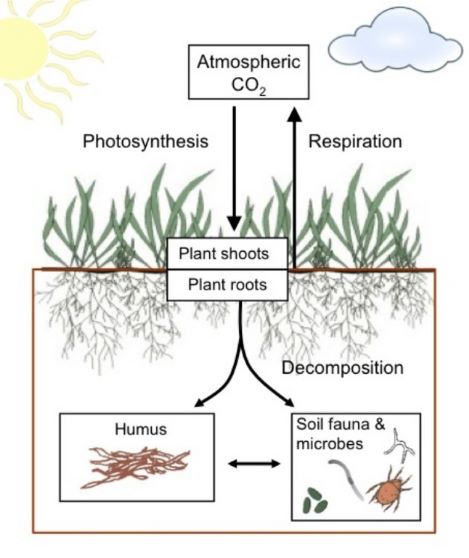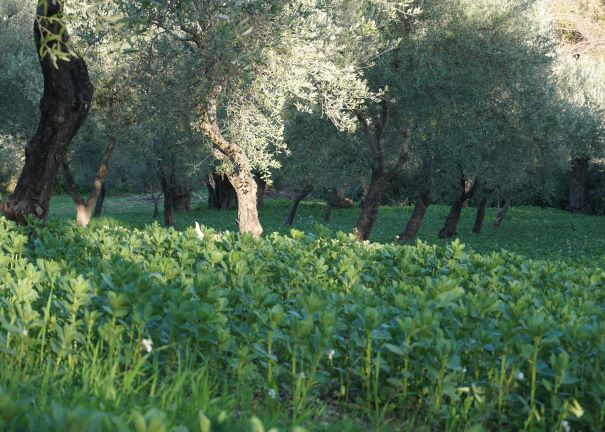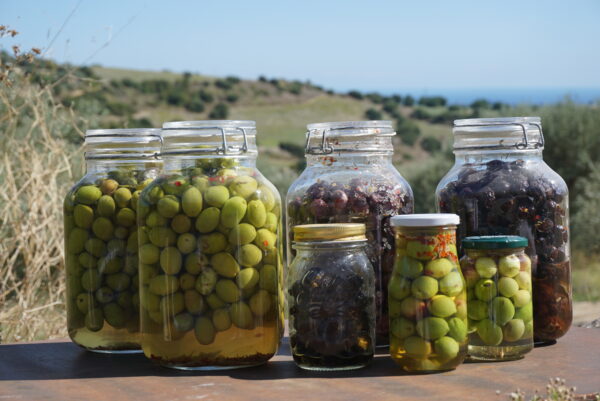
Olive oil in the kitchen – all your questions answered
It is impossible to imagine cooking without olive oil. Although people in the North also cook a lot with butter,

At il circolo we attach great importance to an intact environment. For example, our olive oil is certified organic. This means that it complies with the EU regulations for organic farming and thus we do not use pesticides and fertilisers. New research results that show the possibility of producing olive oil in a climate-friendly way immediately excited us. Our olive oil is not only delicious, but also CO₂-negative and therefore good for the environment.
According to research, there are ways to reduce the CO₂ emissions of olive oil production, even to the extent that CO₂-negative production is possible. The first step is to find out how harmful a product is for the environment. This is done with a life cycle assessment (LCA). This looks at the environmental impact of all elements in the production chain, from the raw materials used to the waste processing. The LCA can thus test whether a product or activity is CO₂-negative.
The exact meaning is disputed among researchers, but 4 criteria are often used to determine whether a product or activity is CO₂-negative.(1)
Almost all production processes require energy – mostly derived from fossil fuels. Among other things, CO₂ is released in the process. However, it is possible for a company not only to emit CO₂, but also to ensure that less CO₂ is released into the atmosphere.
For example, avoiding the use of petrol or diesel-powered vehicles can prevent CO₂ emissions. Investing in an electric vehicle can thus help to reduce emissions.
One method of removing and storing greenhouse gases from the atmosphere is to plant ground covers. These can absorb considerable amounts of CO₂ from the air.(2) It is important that these plants are well suited to the soil and climate conditions. For ground covers, the more that are planted and the longer they stay, the better the CO₂ absorption.
When storing greenhouse gases, it is important that this happens outside the atmosphere. Another effective way to store CO₂ is through trees. These then serve as so-called carbon sinks.(3) The longer the soil around the trees is not ploughed, the more CO₂ is retained. The CO₂ then has more time to be absorbed by humus – the top layer containing plant remains – and by microbes such as bacteria, fungi and other soil organisms. The CO₂ is stored, so to speak, between the roots of the trees on which these organisms live.
This ecosystem is disturbed by (deep) ploughing and part of the CO₂ is released back into the air. Characteristic of CO₂-negative production is that ploughing is done less frequently and less deeply so that this ecosystem is not disturbed and as little CO₂ as possible is released again.(4)
 Source: Ontl, T. A. & Schulte, L. A. (2012) Soil Carbon Storage. Nature Education Knowledge 3(10):35
Source: Ontl, T. A. & Schulte, L. A. (2012) Soil Carbon Storage. Nature Education Knowledge 3(10):35
When drawing up an emissions balance, the balance of stored and emitted CO₂, it is essential that all components of production, distribution and consumption are taken into account. For example, when drawing up the emissions balance for our olive oil, we not only take into account the CO₂ emissions from olive cultivation and olive oil production, but also the emissions caused by transport to our customers. In this way, the total CO₂ emissions and CO₂ storage can be determined.
A product is CO₂-negative if the total amount of greenhouse gases removed from the atmosphere and permanently stored is greater than the total amount of greenhouse gases emitted into the atmosphere from production to consumption. For a negative emissions balance, attention should also be paid to an energy-efficient and environmentally friendly production chain in which CO₂ can be stored. To this end, companies can also make agreements on the compensation of CO₂ emissions, for example by planting trees – as is often offered to air passengers – or by purchasing CO₂ emission certificates.
Greenhouse gases are found in the atmosphere and retain heat from the sun. This is what makes life on Earth possible. As many greenhouse gases are emitted, more heat is trapped. This leads to an increased greenhouse effect, so it gets warmer and warmer on Earth. Together with water vapour, CO₂ is one of the most important greenhouse gases.
Without drastic measures, it could become up to 4.8 degrees Celsius warmer on average in 2100 compared to 2000. This global warming can lead to a change in the climate with many unpleasant consequences such as extreme heat, drought or extreme precipitation and a rise in sea levels. This warming can be reversed – possibly to as little as 0.3 degrees Celsius – if CO₂ emissions are drastically reduced (4).
 Quelle: Poore, J. & Nemecek, T. (2018). Reducing food’s environmental impacts through producers and consumers. Ourworldindata.org
Quelle: Poore, J. & Nemecek, T. (2018). Reducing food’s environmental impacts through producers and consumers. Ourworldindata.org
Agriculture and food production are among the largest contributors to global emissions. More than a quarter of global greenhouse gas emissions come from these sectors. When calculating CO₂ emissions, the entire production chain is considered, not only the production or cultivation of food, but also the transport, storage and use of food all the way to the consumer. There are interesting opportunities to reduce CO₂ emissions in this area. Both food producers and consumers can contribute to this. And this can already be done in a very accessible way. Precisely because it is an adaptation of existing activities. For consumers, for example, through:
In the following, we describe an example of a food manufacturer that pays great attention to reducing CO₂ emissions and even produces CO₂-negative products.
The life cycle analysis (LCA) of olive oil – which shows the environmental impact of all elements of the product, from raw materials to waste disposal – shows that there is potential for a significant reduction in CO₂ emissions. And that it is even possible to produce CO₂-negative. Below we show an example of how il circolo has put this into practice. This is not meant to be a blueprint or a standard, but rather an inspiration to look for ways to further reduce CO₂ emissions.
One of the ways il circolo makes a big difference in emissions is by hand-picking the olives with electric combs that are charged with self-generated solar energy. So no large harvesting machines are used, which reduces CO₂ emissions.
To minimise the footprint of the last part of the production chain, il circolo offsets the CO₂ emissions from transport by planting trees.
By making production processes efficient and circular, they require less energy and raw materials, and fewer emissions and waste are released. In the production of olive oil, il circolo works with a modern mill with a two-stage production process in which no water is added to the olives and thus less waste water is produced. Residual products are used as biofuel.
By applying scientifically researched cultivation methods, such as:

Ground vegetation:
In il circolo’s olive grove, there are ground covers between the olive trees that remove a lot of CO₂ from the atmosphere, such as clover, lupine, legume and other broad-leaved plant species.
No fertiliser, but natural food for the trees:
In winter, the ground is greened by these ground covers, but when it gets warmer, the plants dry out. Beforehand, the plants are ploughed into the soil at the surface so that the soil can utilise the nutrients. It is important that the gentle ploughing is done in good time, because the dry straw of the desiccated plants is a great fire hazard in the hot, dry summers in Sicily.
Minimal and shallow ploughing:
The olive trees themselves, some of which are ancient, serve as carbon stores (4). They not only remove CO₂ from the air. The soil in which the trees are rooted, together with the humus layer and all kinds of organisms in the soil, forms an entire ecosystem that stores CO₂ between the roots of the olive trees. It is important to keep this ecosystem as intact as possible so that the stored CO₂ is not released. Among other things, this means ploughing less frequently and less deeply.
Minimal burning of leaves, twigs and branches:
When the leaves, twigs and branches are burnt, stored CO₂ is released back into the atmosphere, just like when trees are cut down. We try to prevent this as much as possible.
Reducing CO₂ emissions elsewhere in the chain by:
Adapting the delivery, packaging and transport of our olive oil:
il circolo offers consumers the option of buying bulk packs (3 litre and 5 litre bag in box). This not only saves on administration, handling and shipping costs because the consumer has to order less often. It is also more favourable for the ecological footprint because of the lower CO₂ emissions:
With this combination of measures, it is possible to significantly reduce CO₂ emissions. Every litre that il circolo produces (including bottling and packaging) removes up to 5 kg of CO₂ from the atmosphere. With this negative emissions balance, one can say that il circolo is CO₂-negative.
Good olive oil can be bought (online) from the producer himself or in a delicatessen or specialist shop. Olive oil sold in supermarkets cannot really be compared in taste and quality. The reason for this is that these producers often produce on a large scale in order to be able to guarantee delivery to the supermarkets. To make a good choice, websites of olive oil producers or specialised shops provide information on production and other relevant criteria. CO₂-negative olive oil is not yet produced on a large scale, so the options are still limited.
Il circolo produces olive oil organically, CO₂-negatively and is fair to the farmers with whom we collaborate. You can order our CO₂-negative olive oil here.
Sources:
1) Tanzer, S. E. & Ramírez, A. (2019). When are negative emissions negative emissions? Energy & Environmental Science, 12, 1210-1218.
2) Chahal, I., Vyn, R.J., Mayers, D. et al. Cumulative impact of cover crops on soil carbon sequestration and profitability in a temperate humid climate. Scientific Reports 10, 13381 (2020).
3) Proietti, S., Sdringola, P., Regni, L., Evangelisti, N., Brunori, A., Ilarioni, L., Nasini, L. & Proietti, P. (2017). Extra Virgin Olive oil as carbon negative product: Experimental analysis and validation of results. Journal of Cleaner Production, 166, 550-562.
4) https://www.milieucentraal.nl/klimaat-en-aarde/klimaatverandering/wat-is-klimaatverandering/
5) European Commission DG Environment News Alert Service (2015). Science for Environmental Policy. Edited by: SCU, The university of West of England, Bristol.

It is impossible to imagine cooking without olive oil. Although people in the North also cook a lot with butter,

Even though the extraction of olive oil is a big industry, it is not the only product that is made

As producers of olive oil, we are very aware of our dependence on nature. The climate, the soil, the olive

il circolo V.O.F.
Tacituslaan 7
3584AP Utrecht
Netherlands
[email protected]
tel: +31 (0)6 42254141
KvK/HRB: 74704257
BTW/MwSt: NL859998502B01
5 euro discount on your next purchase?
Sign up for our newsletter with tasty recipes and interesting background stories about il circolo olive oil and receive a discount code for yourself and your friends (displayed after email confirmation).
This website uses cookies so that we can provide you with the best user experience possible. Cookie information is stored in your browser and performs functions such as recognising you when you return to our website and helping our team to understand which sections of the website you find most interesting and useful.
Strictly Necessary Cookie should be enabled at all times so that we can save your preferences for cookie settings.
If you disable this cookie, we will not be able to save your preferences. This means that every time you visit this website you will need to enable or disable cookies again.